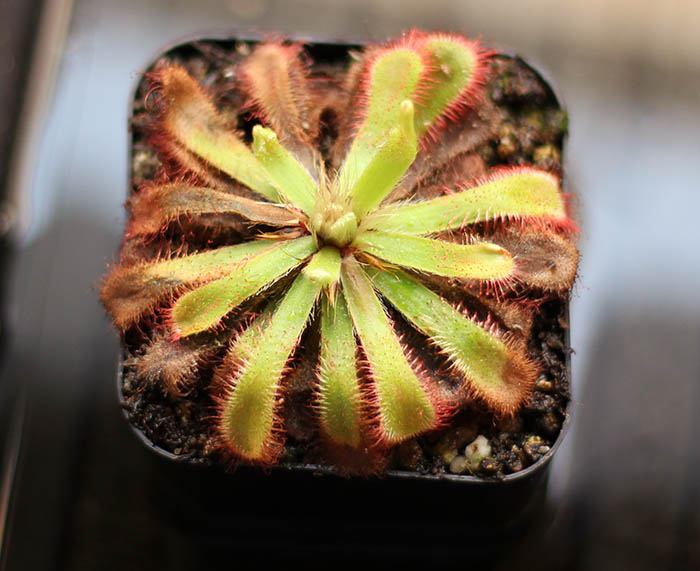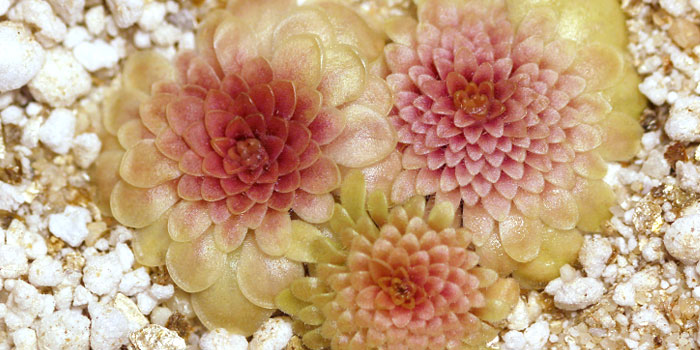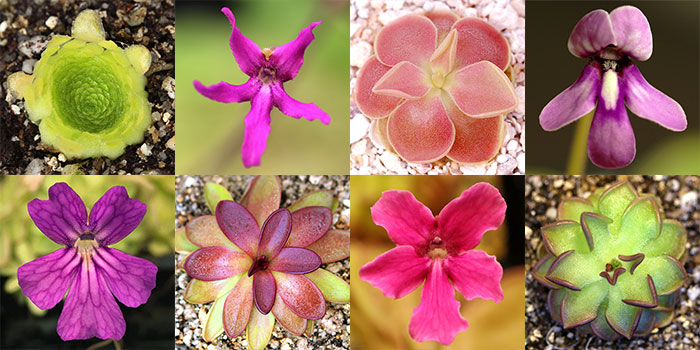You received your new carnivorous plant in the mail and planted it (if shipped bare root). Now it’s time to sit back and enjoy, right? Not so fast. Over the next few days, your plant will go through an important adjustment period as it recovers from shipping and gets used to its new environment. During this adjustment or acclimation phase, there are several things you can do to help make the transition for your plant easier.
Humidity

A carnivorous plant suffering from transplant shock
All of the plants that come from our nursery are used to humidity between 50-75%. However, your plant has spent several days in the mail sealed in damp wrapping which increases humidity to higher levels. If the humidity drops too quickly after arrival, the plant’s roots may not be able to replace water lost through the leaves fast enough and the plant may start to wilt, blacken, or shrink in size. This is known as transplant shock and it can be especially pronounced with bare rooted plants if not managed properly.
How do I control humidity levels?
1. To help your plant slowly adjust to lower humidity and give the roots time to reestablish, we recommend sealing the potted and watered plant in a large freezer bag. This will keep the humidity closer to the levels the plant experienced during shipping. Leave the pot in the sealed bag for 2-3 days. See note below about using this method for tropical and Mexican butterworts.
2. After 2-3 days, peal open a corner of the bag so the top is about 20% open (see image below). Cutting a corner of the bag off or poking holes in it works too. This will drop the humidity around the plant slightly but not enough that the roots will struggle to keep up with replacing lost water.
3. The following day, widen the opening in the bag by another 20%.
4. Continue increasing the size of the opening in the same manner each day until the bag is fully open. By this time, the plant should be acclimated to the humidity levels in your grow space. If you notice wilting during this process, it may be a sign you are dropping the humidity too fast. Give the plant a chance to re-hydrate and try opening the bag in smaller increments over a longer period of time.

Acclimating a sundew to lower humidity using a large freezer bag
A humidity dome with adjustable vents, an empty fish tank, or clear plastic container can also be used for acclimation instead of a freezer bag as long as the there is a way to control the size of openings. If you’d like to fine tune the humidity even further, you can invest in a small hygrometer like this one.
Note: When acclimating tropical and Mexican butterworts, we recommend starting with the bag half open at the beginning rather than fully closed. Butterworts don’t require as much humidity initially compared to other types of carnivorous plants. In fact, too much humidity could put them at unnecessary risk of crown rot.
What about airflow during the acclimation phase?

Tip: It’s best to start with new media when acclimating bare root plants, preferably a mix that contains well rinsed and/or sterilized ingredients like ours. Good airflow becomes much more important at the very beginning if you are reusing soil. Used soil has a much higher spore and bacteria count and can overwhelm a new plant more easily than using fresh soil.
Can I mist my plant to keep the humidity high?
For butterworts, sundews, and other dew-producing plants, we do not recommend misting. Misting can cause unnecessary stress by washing away the dew the plants work hard to produce. This means they will have to expend extra energy replacing it. For other types of carnivorous plants like Nepenthes and Heliamphora pitcher plants, misting can be beneficial. A humidifier or fog machine running on timed intervals works well, however sporadic or manual misting will only raise the humidity temporarily and it will be difficult to maintain consistent levels around the plant.
Temperature

Acclimating plants to humidity levels using a plastic bag or dome can sometimes present a challenge with heat build up. The temperature in a sealed bag left in the sun, even indoors on a windowsill, can skyrocket to 100+ °F in no time due to the greenhouse effect. The hygrometer we mentioned earlier also doubles as a thermometer and can help monitor temperatures. Offsetting humidity and light acclimation (explained below) is a good way to help minimize heat build up as well.
Tip: Soil mass can have a significant affect on temperature (and moisture) stability and is worth considering when growing carnivorous plants, especially if they will be outdoors. Plant roots in a large pot of soil or planted directly in the ground will heat up and cool down slower than those in a small pot. Gradual temperature shifts will lead to happier plants.
Light
At this time, we grow most of the plants in our nursery using either artificial light or filtered sunlight. This means they aren’t used to high levels of UV radiation from direct sun. If you plan to grow your plant outdoors, it will be important to adjust it slowly to this more intense form of light. Sometimes you can do this at the same time as humidity acclimation with extra care that the plant doesn’t overheat. For the safest route though, adjust the light levels after humidity acclimation to keep temperatures lower.

How do I control light levels?
The process for acclimating your plant to stronger light is similar to humidity acclimation. The idea is to expose the plant to the preferred light conditions in increasing amounts over several days:
1. For the first 2-3 days after delivery and potting, the plant should stay out of direct sun. Setting the pot on a window sill that receives indirect light or a shaded spot outdoors is best. An artificial light that won’t get too hot like a compact fluorescent bulb or white LED also works.
2. After 2-3 days, place the plant in direct sun for 1-2 hours only. Ideally, start in the morning since the sun will be less intense.
3. The following day, leave the plant in the sun for 2-3 hours.
4. Continue increasing the amount of exposure time by 1-2 hour increments each day until the plant remains in full sun through the afternoon. If you notice leaf burn or wilting, this can be a sign acclimation may be moving too quickly and you need to slow things down.
What if I only want to use artificial lighting?
Go for it! The steps above still apply, but you won’t need to follow them as strictly since UV radiation is less of a concern. Humidity acclimation and temperature monitoring will still be important though.
What kind of light is best for my plant and how much does it need?
These are big questions and we’re glad you asked! We have a whole series on light for carnivorous plants to help answer them:
- Part 1 – What type of light do carnivorous plants need?
- Part 2 – How much light do carnivorous plants need?
- Part 3 – Which grow lights are best?





Hi! I just received my Mexican Butterwort in the mail and have him potted with the Mexican Butterwort potting mix already and he seems happy. I am having a hard time finding how often I should be watering my new plant and how wet the potting mixture should be for the best growing conditions.
Thank you!
Hi Corinn, glad to hear your butterwort arrived happy and safe! When the plant has carnivorous leaves, keeping the soil just damp at the surface is a good goal. Usually watering once or twice a week from the bottom of the pot is enough. Thank you!
I must have done something wrong during this acclimation process, because near the end I noticed that my two sundews have started to suffer some white mold on a few of their trap leaves. I took them out of their bags and brought them into stronger lighting. Will the plants be able to fend themselves off now that they are spending more time in the sun and have more air, or should I be doing something about it? Should I remove the moldy plant material, or will that stress the plant further?
Oof, I meant to say “fend this off themselves” instead of “fend themselves off”. Sorry!
Hi Mark,
If there are small patches of mold on a couple of the leaves this shouldn’t be harmful to the plants, especially now that they are in stronger lighting and have more airflow. If you want to be extra safe though, a small spritz of water will usually clean it off. If the mold patches are larger or there is mold forming on dead leaves, it may be beneficial to remove those leaves to prevent the mold from spreading to other areas.
Hi!
Received three beautiful Cape Sundews and planted them in a terrarium.
After a few hours they looked a little sad, but had snapped back significantly the next morning.
I am keeping humidity up in the eighties, but I notice they have all lost their ‘dew’…
Should I be concerned?
Hi John, glad to hear they arrived safely! It can take a few days for the dew to return after shipping but once the plants start settling in a little more, it will come back and they’ll be able to catch bugs again.
Hey. My cape sundew arrived looking beautiful but I accidentally let it dry out the first day and now it is wrinkly and sad looking (like the pic in the article). This article talks about avoiding transplant shock in the first place, but once they do have it can they recover? Or do I need to try again?
(I’m kicking myself so hard right now.)
Hi Krystal, I’m sorry to hear it dried out! As long as there is a little green left, it should still bounce back. Even if most of the leaves are gone, cape sundews are pretty good about growing back from the roots.
Good to know! Thanks!
So these pings/butterworts (Pinguicula esseriana & Pinguicula ehlersiae `Victoria) just came in the mail right now. I also just finished transplanting them into the Mexican potting mix.
Should I also put it in a small bag for the humidity to come up as well? Or just leave it as it is In the new pot that it’s in?
For Mexican butterworts, we don’t recommend putting them in a bag for the extra humidity. They are much more tolerant of lower humidity out of the box and if levels are too high it can actually be bad for them. Thanks!
Awesome! Thank you!
Hi…. Sir… In which day we can introduce the plants to the sun?
Hi Sarang, typically we recommend introducing the plants to sunlight after they have adjusted to lower humidity to avoid overheating while in the plastic bag or under a humidity dome. I should also clarify that this is in regard to direct sunlight, it is still necessary to provide indirect sun or a cool source of artificial light while the plant is undergoing humidity acclimation. This will allow the plants to continue with photosynthesis without overheating.
That article was of great help, my plant arrived today in great condition, so after I unboxed it and repot it following the instructions that came with it. but I’m worried about extreme heat. I live in Florida and we are in summer and the temperatures here right now are in the high 90’s. I plan to keep my carnivorous plant in the lanai along with some orchids that I have. They’re all under the roof and in the shade. Lots of sun light and the heat. Should I keep the carnivorous plant outside until it is climatized or put it inside????
Hi Sharon, I’m glad the plants arrived happy and you found the article helpful! With the temperatures so hot in Florida right now, keeping the plants indoors until they have a chance to settle from shipping/potting would be best. Once they have reestablished themselves, moving them to the shade under the lanai should be ok. Thank you!
Great article! Just a question about watering Cape sundews during humidity acclimation. It looks like the bag shown in the above picture does not contain standing water, so I guess the plant should get a thorough surface watering before being placed in the bag and then watered via the tray method only once it’s out of the bag? Thanks!
Thanks Matt! That is correct, you’ll want to water the plant well before placing it in the bag. You could also put some water in the bottom of the bag too if you prefer not to surface water during the acclimation period, either way works :) I hope this helps!
Hi!
I just received my Drosera Spatulata and Drosera Capensis today and am THRILLED with the excellent quality of my “babies”. I watched the video, twice and now have them both planted and sealed near a window that gets low light.
Question, when do I need to start feeding them? I have some Betta food – dried blood worms at the moment. I did a lot of looking about as to how to care for these adorable little ones, but couldn’t remember when they need to eat.
Again, I am VERY HAPPY and pleased as punch with my two new babies!
~Deborah
Hi Deborah, so glad to hear you are happy with your plants and found the instructions helpful! For feeding, you’ll want to begin after the plants are out of the humidity bags and have begun producing dew again. If you feed them while in the bags, it will increase the chances of molding. Once they are in room level humidity and producing dew, it’s a good sign they have settled and are ready to eat :)
Thank you!
~ Elizabeth
Hi! I got two questions!
What if you received a plant potted and conveniently covered for avoiding dehydration but plastic only covered the 2/3 upper of the pot and not all pot? Could you keep the upper plastic or bag and profit airflow from down? Or should I anyway put in freezer bag as you said.
Last question. If you buy a CP in a local store (which could have the same climate but obviously not the same parameters) but the plant has not been sent in a bag with 95-100% humidity for the dehydration issue, process of acclimation in a freezer bag is still necessary?
I mean, humidity acclimation process is made because of stomas opening due of high humidity levels in bag package? So if plant is not sent this way, there shouldn’t be risk of dehydration?
Thank you so much!
Hi Guillermo,
If you have a potted plant that was shipped, it can still be beneficial to use the freezer bag to control humidity. The humidity control can help reduce the risk of dehydration if the stomata are wide open like you said and it can help ease the plant into the new growing conditions if humidity levels are substantially different from the nursery’s.
Plants bought at a local store are less likely to need as much acclimation since the base conditions would ideally be similar. It’s good to observe conditions at the store though as some light and humidity acclimation may still be beneficial.
Thanks for your questions!
My plants came today. Yeay! They are not Mexican butterwort, but are a hybrid, with one parent being the Mexican butterwort.
Do I follow the directions for acclimation? Or follow the “not recommended for Mexican butterwort”?
Help!! Thanks so much. –Ann
Hi Ann, I’m glad to hear they arrived! The plants you have are a hybrid of two Mexican butterwort species so you’ll want to follow the instructions above but take note of the caution for this type of plant and skip the extra humidity. Enjoy your new plants!
Thank you,
Elizabeth